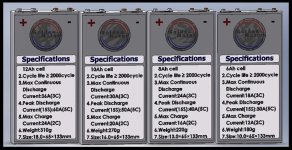steverichab
10 mW
- Joined
- Oct 2, 2011
- Messages
- 21
Hello:
I have two E-Bikes that need new controllers and I have purchased 2 controllers from
Amazon: https://www.amazon.com/dp/B074FYSJKW/ref=cfb_at_prodpg
Here is a video of the setup & problem: https://www.youtube.com/watch?v=WE4Ks6s1VWE
Here is how both controllers are wired to 48 V, 1000 W (Magic Pie 3) hub motors with internal controllers removed:
1) 48 V LiFePo battery The read 52.2 V and have very little "sag" when running
2) Throttle
3) Hall Sensors
4) Phase wires
The jumpers installed are: Lock=>"power lock" (orange-red), High Speed=>"Stalls"(blue-black), Direction of rotation=> "inverted gear(black-grey).
Please tell me why both controllers stall/trip at 4 to 5 amps but run fine at less load? The vendor suggested these jumpers but still no go.
Any help is greatly appreciated
I have two E-Bikes that need new controllers and I have purchased 2 controllers from
Amazon: https://www.amazon.com/dp/B074FYSJKW/ref=cfb_at_prodpg
Here is a video of the setup & problem: https://www.youtube.com/watch?v=WE4Ks6s1VWE
Here is how both controllers are wired to 48 V, 1000 W (Magic Pie 3) hub motors with internal controllers removed:
1) 48 V LiFePo battery The read 52.2 V and have very little "sag" when running
2) Throttle
3) Hall Sensors
4) Phase wires
The jumpers installed are: Lock=>"power lock" (orange-red), High Speed=>"Stalls"(blue-black), Direction of rotation=> "inverted gear(black-grey).
Please tell me why both controllers stall/trip at 4 to 5 amps but run fine at less load? The vendor suggested these jumpers but still no go.
Any help is greatly appreciated



